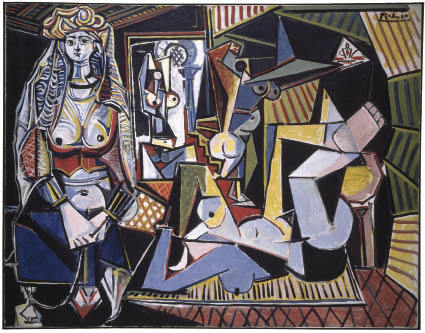Picasso: Challenging the Past
National Gallery, until 7 June
The ostensible subject of this show is Picasso’s relationship with past art, and accordingly the visitor might expect to see great works of the past hung next to Picassos for purposes of comparison. This does not occur. The exhibition contains only some 60 paintings by Picasso, some of which indeed evince references to particular Old Masters, though others don’t, apart from showing the kind of sound knowledge of art history which used to be expected of artists, before the foppish ignorance of today became fashionable.
If it’s incongruous to find a key modernist in the National Gallery, that repository of the historical, the justification for this show is presumably its relevance to the National’s permanent collection. Sadly, the Picasso pictures most closely tied to Old Masters are based on Manet’s ‘Déjeuner sur l’Herbe’, which is in the Musée d’Orsay, Velásquez’s ‘Las Meninas’ in the Prado, and Delacroix’s ‘Women of Algiers’ in the Louvre. Nothing, you see, from the National Gallery. The idea that you can just pop upstairs from the Picasso show and see his models and inspirations in the permanent collection doesn’t really work.
However, Picasso is rarely boring, so I was expecting something of a visual treat. The reality was strangely unsatisfying. There are some extraordinary paintings on show, but I wish I was more moved by them. (There was nothing of the emotion I felt on entering the great Cézanne exhibition at the Tate in 1996.) I acknowledge the formidable intelligence, the ruthless urge to create, and admire, even love, some of the earlier works, but so many leave me cold. They seem to be about distress more than celebration, heartlessness and ingenuity rather than compassion. This could, of course, be an effect of natural light deprivation. Some paintings suffer worse than others under artificial light in the NG’s basement galleries. Picasso — always more of a draughtsman than a robust or natural colourist — perhaps suffers more than anticipated. All that green in his Manet variations, for instance. It doesn’t look good. Yet another reason for not hanging exhibitions in this bunker.
As is the fashion nowadays, each room in the show is allotted a sub-theme, so that paintings are not hung with the logic of chronology, but grouped by subject. This works fine when the sub-theme is ‘Self-Portrait’, as it is in room 1, but such designations as the ‘Models and Muses’ and ‘Characters and Types’ of later rooms are too loose to make useful categories. Then the notion of theming appears for what it is — woefully limited, and too often leading to compromise. I’d rather the pictures were hung simply to look their best, in the most effective juxtapositions.
Picasso was a lifelong devotee of the cult of personality, so it’s appropriate that there’s a large black-and-white photo of him at the entrance to the show, looking a bit of a rogue, wearing a straw hat and open shirt. Stylish, of course. Compare this image to the teenage self-portrait in a wig, in room 1, slightly Goya-esque, and scarcely recognisable as being of or by Picasso. Very different from the compelling calm of the 1906 ‘Self-Portrait with Palette’, archaic yet serene, which in turn contrasts splendidly with the fizzing 1938 image of a man in a straw hat, psychedelic and as mad as van Gogh. The second room leads us into nudes and such delights as ‘Reclining Nude Playing with a Cat’ (1964), with its echo of Manet’s ‘Olympia’. Also in this room is the splendidly rounded and statuesque, not to say chunky, figure of ‘Large Bather’ (1921), next to the ethereal Cubist fracturing of ‘Seated Nude’ (1909–10), which has no weight or physical presence at all. Now look across at the angry colouring and whiplash lines of ‘Sleeping Nude with Blonde Hair’ (1932), one of the least voluptuous of images. That they’re by the same artist remains something of a salutary shock.
Room 3 offers a mixture of things: an early head in the flickering flame-like style of El Greco, a much later painting of the artist as a Musketeer (he’d been reading Dumas), and an exceptionally mocking portrait of Jaime Sabartes, Picasso’s right-hand man, portrayed here as a Spanish nobleman with rosebud lips and shattered spectacles. The next room you come to is confusingly called Room 6, so the visitor is presumably intended to cross this large space with eyes shut in order to dive into Rooms 4 and 5, containing more models and muses and a group of still-life paintings respectively. In 4, there’s a key Blue Period portrait, ‘Girl in a Chemise’ (c.1905), frail and interesting, very different from the bird-of-prey rapacity of the prostitute in ‘The Absinthe Drinker’ (1901), but the room is dominated by the restrained realism of ‘Portrait of Olga’ (1923), Picasso’s then wife, which makes reference to Ingres. The still-life paintings are a lovely group, showing the early influence of Cézanne and Picasso’s gift for the memento mori.
In the last room are several of his variations on well-known paintings. This should be the heart of the show, but to me it rings oddly hollow. There’s a terrible sense of aridity here, not the human richness I’d hoped for. As an astute commentator once wrote: ‘Nothing unites the English like war. Nothing divides them like Picasso.’ How true is either proposition nowadays? Will Picasso’s magisterial distortions still beguile some and alienate others? Has the pulling power of the old magician diminished? He said: ‘I am only a public entertainer who has understood his time.’ But has his time passed? I wonder how many people who don’t usually look at art or visit the National Gallery will take a trip to Trafalgar Square on the strength of this exhibition.






Comments